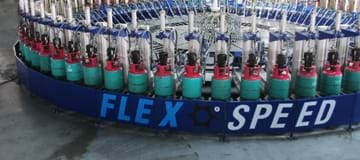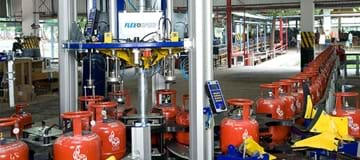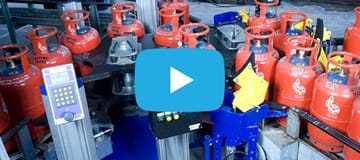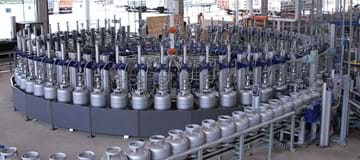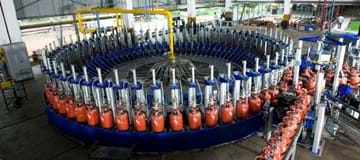The story behind FLEXSPEED
FLEXSPEED trebles the capacity on the same space as a traditional filling plant. It is an extremely simple system that increases the accuracy in filling, check-weighing, leak testing etc. and at the same time reduces maintenance to a minimum.
Mr. Bent Lindrup, Technical Director of The Kosan Crisplant Group, is excited when he tells about the unique features of FLEXSPEED:
“A colleague of mine is in the beverage business and knows the dynamic bottle feed systems.” explains Bent Lindrup. This became the source of inspiration for the system.
The goal for the team of developers was to fill 3,600 gas cylinders per hour. Defining the top level this high (the capacity at traditional filling plants is 1,200 cylinders per hour) it was imperative to think out of the box.
Inspired by beverages
For the last 20 to 30 years the beverage industry has used the technology for conveying bottles, cans and casks. It is an efficient and well-tried technology and so Kosan Crisplant’s team of developers visited a few beverage companies in Denmark in their quest for an answer.
“It gives you peace of mind to work with existing technology”, Bent Lindrup adds and says that Kosan Crisplant also approached a design agency that is well-rooted in the beverage industry to assist in transferring the principles from filling beverages to those that apply for the future world sensation in gas filling plants.

The wheel is the star
The stars or star wheels that are used for distributing the gas cylinders from one process to the next became the solution that makes FLEXSPEED unique and dynamic. The star wheels ensure a constant flow of gas cylinders from the first to the final processing unit without stopping the movement of the gas cylinder at any one point.
A simple and perfectly innovative solution was the spark that started the inventiveness of the involved technicians.
The gas cylinders were not only to be refilled, but also tested for leakage. “Why not maintain the grip on the cylinders from the ejection star wheel over to the next process?” the team of developers asked themselves.
In traditional gas filling plants the actual handling of gas cylinders takes a lot of time. Two thirds of the time is used for moving the gas cylinders leaving only one third for processing. With FLEXSPEED it is the other way around.
The gas cylinders dynamically enter a star wheel with six positions and which revolves 180 degrees before the cylinders are delivered to the next process.
The Technical Director explains it this way, “This means that even when we run the system at three times the speed we did before, we now have two to three times the time needed for performing the test and so a much better opportunity to perform a perfect leak test, cap application etc.”
Intelligent features
Another essential feature with FLEXSPEED, and just as important, is that the gas cylinders are topped up and check-weighed as they revolve on the filling carrousel.
The check-weighing and the topping-up of the cylinders were integrated in the filling process. Bent Lindrup illustrates the process in more detail.

Topping up filling
According to Bent Lindrup, "the overall advantages for FLEXSPEED customers are that the system consists of but a few units; a mechanical parallelogram, a simple filling unit and a stationary high-tech weighing cell and a computer. Everything is modular which means that we can easily make a ‘plug-and-play’ replacement.”
A simple principle
The zero-set scale controls how much each filling unit weighs. It is the same principle that applies for kitchen scales that are zero-set to compensate for different types of bowls or containers.
The tare value of the filling unit and the tare value of the gas cylinder are added to the weight of the gas.
Example:
22 kg Weight, filling unit
11 kg Weight, gas cylinder
11 kg Weight, LP Gas Gross
----------------------------------
44 kg Weight



